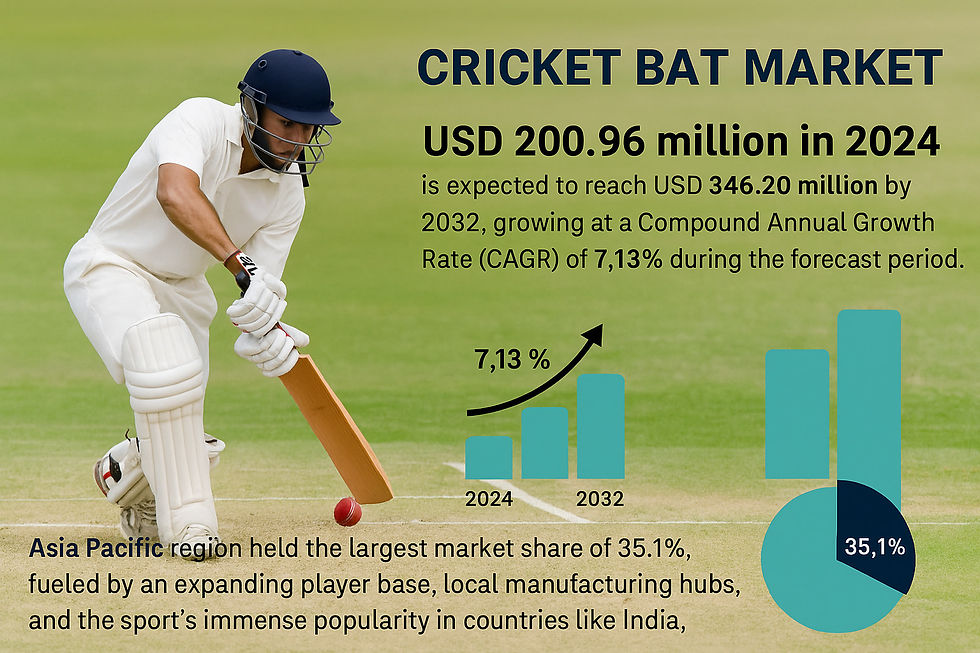Global Hair Conditioner Market Share, Trends & Outlook 2032
- Reddy S
- Jul 28
- 4 min read
According to Fortune Business Insights, the global hair conditioner market is witnessing a robust expansion, driven by increasing consumer awareness, the influence of social media, and a surge in e-commerce sales. Valued at USD 4.81 billion in 2024, the market is expected to reach USD 5.04 billion in 2025 and further grow to USD 8.26 billion by 2032, reflecting a CAGR of 7.31% over the forecast period.

Key Market Trends
Celebrity and Influencer Collaborations Brands are leveraging social media endorsements to expand reach and build consumer trust. Collaborations with influencers and celebrities play a critical role in consumer purchasing decisions and brand visibility.
Product Innovations with Technological Integration Companies are investing in technology-infused products, such as microencapsulation techniques, to improve product performance. Customization and targeted formulations for hair types like curly, color-treated, or dry hair are gaining traction.
Request FREE Sample PDF Copy of Hair Conditioner Market: https://www.fortunebusinessinsights.com/enquiry/request-sample-pdf/hair-conditioner-market-113198
List of Key Hair Conditioner Companies Profiled:
L'Oréal SA (France)
The Procter & Gamble Company (U.S.)
Unilever plc (U.K.)
The Estée Lauder Companies Inc. (U.S.)
Shiseido (Japan)
Kao Corporation (Japan)
Beiersdorf AG (Germany)
Johnson & Johnson (U.S.)
Amway Corporation (U.S.)
Oriflame Holding AG (Switzerland)
Key Market Insights & Growth Drivers
Evolving Consumer Awareness & Social Media Influence
Growing awareness about hair health and the benefits of conditioning, largely amplified by social media influencers and beauty content creators, has played a pivotal role in driving market expansion. Platforms such as Instagram, YouTube, and TikTok serve as key avenues for product promotion, user reviews, and personalized hair care tips.
Strong E-commerce Infrastructure
The convenience of online shopping continues to bolster the market. In 2024, U.S. e-commerce sales hit USD 1,192.6 billion, up 8.1% from 2023. Online platforms offer wide product availability, detailed reviews, and comparative pricing, increasing consumer engagement.
Product Customization & Natural Formulations
Consumer preference is rapidly shifting toward natural, sulfate-free, and cruelty-free hair conditioners. This trend is prompting companies to invest in innovative, plant-based products. For instance, brands like Fiore and Atulya are introducing vegan and sustainable hair conditioners that address seasonal and hair-type-specific concerns.
Market Segmentation Overview
By Product Type:
Rinse-out conditioners dominate due to their quick application and immediate benefits.
Leave-in conditioners are gaining popularity for their convenience and long-lasting hydration.
By Form:
Synthetic conditioners lead the market owing to affordability and easy retail access.
Natural conditioners are experiencing rising demand due to health-conscious consumer behavior.
By End-user:
Women constitute the largest user base due to diverse hair needs, such as damage repair and color protection.
Men are increasingly investing in conditioners, supported by evolving grooming trends and product availability.
By Distribution Channel:
Supermarkets & hypermarkets dominate with wide product assortments and in-store comparisons.
Online platforms are rapidly growing due to their ease of access and product variety.
Regional Analysis
Europe: With a 38.03% market share in 2024, Europe leads the global market. The region benefits from strong brand presence (L’Oréal, Unilever, Henkel), advanced R&D, and robust distribution. Technological innovations, such as L'Oréal's advanced XTS production system in France, continue to improve efficiency and scalability.
Asia Pacific: Urbanization, rising disposable income, and growing concerns about pollution-induced hair damage are key drivers. In India, for example, disposable income increased to USD 3.55 million in 2023, prompting consumers to spend more on premium hair care solutions.
North America: A growing preference for organic and botanical-based hair products is fueling demand in the U.S. market. The country also benefits from a well-established retail ecosystem and increasing male grooming trends, with Q4 2024 retail e-commerce sales reaching USD 352.9 billion.
South America & Middle East & Africa:
South America is witnessing a shift from chemical-based to natural hair conditioners.
Middle East & Africa show potential due to their young population, increasing grooming awareness, and growing demand for premium natural products.
Challenges and Restraints
Counterfeit and Low-Quality Products The market faces challenges from counterfeit goods, especially in emerging economies. These products can damage brand reputation, pose health risks, and lead to a loss of consumer trust.
Opportunities for Market Expansion
Niche Segment Targeting & Technological Advancements Rising demand for conditioners tailored to specific demographics or hair types offers opportunities for differentiation. Advanced formulations, such as vegan keratin or pollution-protection blends, allow companies to tap into under-served niches.
Competitive Landscape
Top companies are focusing on strategic partnerships and brand collaborations to expand their product offerings. For instance, Native launched collaborations like Native x Dunkin and Native x Jarritos, combining personal care with popular cultural elements. Such collaborations not only enhance product appeal but also drive deeper consumer engagement through co-branded experiences.
KEY INDUSTRY DEVELOPMENTS
September 2024 – Dove, a brand of Unilever, unveiled the Glycolic+ Hydration range of shampoos and conditioners designed to provide long-lasting hydration for dry and damaged hair. This innovative line features Hydra-Glycol, a key ingredient that helps restore moisture and maintain hydration for up to 100 hours.
July 2024 – TRESemmé, a brand of Unilever, launched the Lamellar Shine hair care range, including conditioners, in several countries, such as the U.K., Argentina, Mexico, and Brazil. This innovation delivers an ultra-glossy finish, aligning with the growing consumer demand for shiny hair.
The global hair conditioner market is poised for significant growth, propelled by increased consumer awareness, preference for natural products, and digital retail expansion. As brands continue to innovate and engage with consumers through social media and e-commerce, the market is expected to witness sustained momentum through 2032.







Comments